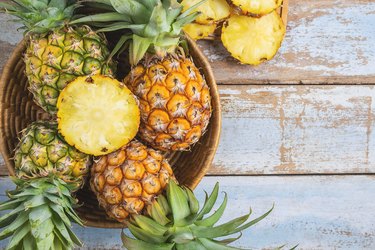
Crushed pineapple packed in heavy syrup may be a thing of the past as more cooks discover the artificial ingredients used in the syrup. Crushed pineapple is now usually packed in 100 percent pineapple juice and the labels distinctly boast the health benefits. When purchasing crushed pineapple for a recipe or just as a snack, check the labels to see the differences between crushed pineapple in juice and crushed pineapple in heavy syrup.
The Basics of Canned Crushed Pineapple
Video of the Day
When canning crushed pineapple, commercial companies heat it first as part of the preservation process before packing it in water, juice or syrup. This heating denatures the enzymes naturally present in fresh pineapple, making it suitable to use in recipes that contain gelatin. Never substitute fresh pineapple for canned in recipes with gelatin because the enzymes naturally present in fresh pineapple cause the gelatin to break down into liquid and the dish won't set. Both crushed pineapple in juice and crushed pineapple in heavy syrup are suitable for use in gelatin recipes. The difference is that crushed pineapple in juice is packed in the juice from the pineapple itself and crushed pineapple in heavy syrup is packed in a mixture of sugar and water instead of juice before canning.
Video of the Day
The Difference is Added Sugar
All fruit and juice contain some amount of natural sugar. That's why the labels on crushed pineapple in juice still lists some sugar under the carbohydrate count. However, crushed pineapple in juice contains no added sugar. Crushed pineapple in heavy syrup contains the natural sugar from the pineapple as well as additional sugar and artificial nutrients used to replace the nutrients boiled away in the syrup-making process. Crushed pineapple in heavy syrup contains approximately 25 percent to 30 percent more carbs and sugar than crushed pineapple in juice.
Counting Calories
Because crushed pineapple in heavy syrup contains added sugar and carbohydrates, it also contains more calories than crushed pineapple in juice. Each serving of crushed pineapple in juice saves approximately 20 calories per half-cup serving over crushed pineapple in heavy syrup. Although both servings contain the same amount of fruit, the added sugar in the canning liquid adds calories.
Uses for Crushed Pineapple
Cooks use crushed pineapple in heavy syrup and crushed pineapple in juice in different types of recipes. Crushed pineapple in heavy syrup works well when it is the chief sweetener in a dessert or topping. For instance, a pineapple cake that requires little or no additional sweetener may call for crushed pineapple in heavy syrup. Create a quick cake frosting from cream cheese mixed and sweetened with the crushed pineapple in heavy syrup. On the other hand, dishes that already contain sugar or sugar substitute such as gelatin desserts may call for the crushed pineapple in juice because no extra sweetener is needed.
Reading the Labels
Once you've decided on the type of recipe you're making and whether it calls for crushed pineapple packed in juice or syrup, go the extra mile and read the label on the can. If agave is used as a sweetener in the syrup, the pineappe will be high in calories. If corn syrup is used, that's considered an ingredient with no essential nutrients. It also adds calories and contributes to weight gain. Be label smart!